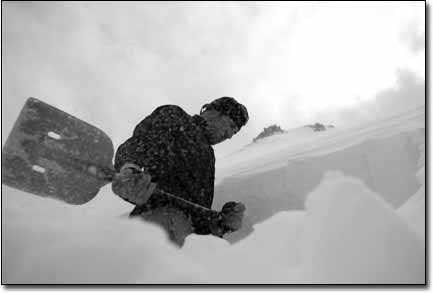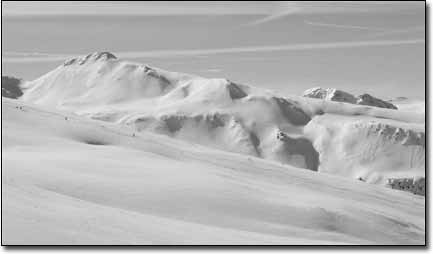|
Typically sketchy snow year shapes up in the San Juans

|
|
Jacob Nacht, of Ridgway, digs a pit on a slope near Ophir Pass. Pit analysis, combined with other observations, help backcountry travelers make better decisions on route selection./Photo by Jared Boyd
|
by
Shawna Bethell
With three major skier-triggered avalanches in the San Juans already this season,
the question that comes to most backcountry minds is, "Wow, is this snowpack
unusually unstable, or are people just getting more irresponsible?"
As with most of life's questions, the answer lies somewhere in the middle, according to local avalanche experts.
"I think what we are seeing out there is that people are expert skiers, but beginner mountaineers," said Jerry Roberts, Avalanche Forecaster for the Colorado Avalanche Information Center (CAIC). Roberts forecasts Highway 550 for the Colorado Department of Transportation, and he also is a snow safety consultant for the Chilean mining industry. With more than 30 years of experience in the snow, Roberts has the type of history that seems to make a difference in a year like this: a typical year in the San Juans.
Snow in the San Juan Mountains is notoriously unstable for numerous reasons that snow scientists love to discuss. But to make it easy on the novice, suffice to say that warm daytime sun, cold nighttime temperatures and steep terrain combine to make the area around Silverton one of the most avalanche prone in the Lower 48. However, what may have changed this season is a growing sense of complacency among backcountry skiers or a lack of history watching snow in the region.
According to CAIC, this year's snowfall patterns are consistent with a typical San Juan snowpack. Historically speaking, it is common to have snow early in the year that lingers on north-facing aspects, such as those that ran in October at Anvil, Battleship and Storm Peak. Due to warm daytime temperatures, that snow becomes shallow, less than 3 feet. In turn, cold nighttime temperatures turn that shallow snow into what is known as "sugar snow," or grainy, faceted snow which tends to lack cohesiveness. When more snow is heaped onto this unstable layer, the snowpack becomes highly avalanche prone. This is typical for the San Juans. However, because of the dry conditions of the past four or five years and lack of early snow, many folks who ski these slopes aren't aware of the notorious instability of early season. And that sets them up for dangerous circumstances.
"People just aren't aware," said Roberts. "Although the Avalanche Information Line wasn't operating yet (when these slides occurred), if people had talked to locals, it may have made a difference."
Dale Atkin, avalanche forecaster for the Boulder CAIC office, concurs.
"If people are relying on their experience of
4
only the past four or five years, it's likely there may be accidents or close calls."
Old timers, he says, or people who have been around the San Juans for years, know this snowpack, and there is a difference between someone's skill as a skier and their skill in avalanche awareness. In other words, just because someone can rage down a slope and catch first tracks doesn't mean he or she has any knowledge of how to stay safe in consistently avalanche-ridden terrain.

|
|
Despite the slope’s gentle pitch, this popular backcountry ski run (McMillan's) near Red Mountain Pass does have a history of avalanching./Photo by Jared Boyd
|
Old timers, he says, or people who have been around the San Juans for years, know this snowpack, and there is a difference between someone's skill as a skier and their skill in avalanche awareness. In other words, just because someone can rage down a slope and catch first tracks doesn't mean he or she has any knowledge of how to stay safe in consistently avalanche-ridden terrain.
"I don't see anything markedly different about this year," said Chris Nute, coordinator of Outdoor Pursuits at Fort Lewis College and former Silverton Avalanche School director. "What I've seen is a gradual, progressively more aggressive attitude toward backcountry and early year skiing and less regard for avalanches."
 People appear to feel a pocket of safety in areas along highways and ski areas, and the Silverton area has both. Coal Bank Pass and Red Mountain Pass are both heavily skied regions, and Silverton Mountain Ski Area is nearby. People appear to feel a pocket of safety in areas along highways and ski areas, and the Silverton area has both. Coal Bank Pass and Red Mountain Pass are both heavily skied regions, and Silverton Mountain Ski Area is nearby.
"I remind my students that the moment they step away from Highway 550, they are in the Colorado backcountry. Just because control work is done for the highway, doesn't make it safe to ski."
Another factor related to skier-triggered slides is that there are simply more skiers out there. With the opening of Silverton Mountain, the region has become more and more popular as a ski destination, the "aura effect" as it was put by Chris Nute.
"It's undeniable that since the ski area opened, there have been increasing numbers of skiers in the San Juan backcountry," he said, and Roberts agrees.
"Hell, years ago I can remember going to Red Mountain Pass on a weekend and seeing maybe five or six cars parked up there," Roberts said. "Now there are 20 or 30 cars there every weekend. Unfortunately, many of them aren't using good ski protocol. They'll be skiing above other skiers and everything else."
All the "experts" agree that what needs to be most expressed is avalanche awareness and training: go to classes and carry avalanche rescue gear; call the Avalanche Information Line for conditions; be prepared and be willing to walk away from that fresh powder if necessary. The old timers will tell you it's better to walk away from a high risk slope, than to risk everything for first tracks.
"Five or 10 years is not a very long time when it comes to avalanche and snow experience," says Dale Atkin. "Even the old timers learn something new each season. You just have to learn to be aware, or Mother Nature may teach you the lessons."
And Mother Nature can be a very harsh teacher.
☯
|